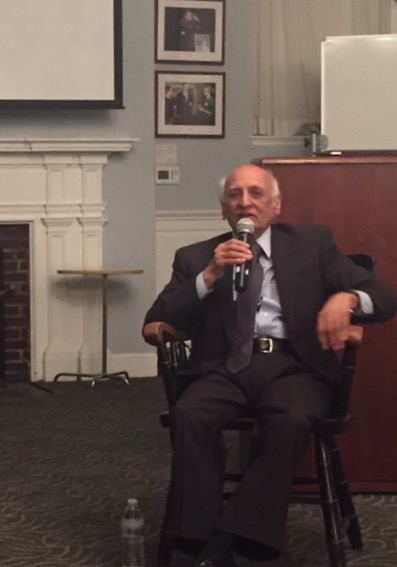By Meenakshi Chhabra
CAMBRIDGE, MA–Memories that are kept alive to cultivate old hatreds and resentments are likely to culminate in vengeance and violence. Memories that are kept alive to transcend hatred have the potential to heal wounds.
More than forty people of Indian, Bangladeshi, Pakistani, and United States origin, gathered together, on the evening of the 22nd of March to commemorate the 70th anniversary of the 1947 British India Partition. The event titled, “Voices of Partition,” was hosted by Lesly University in Cambridge, as part of their annual series, Future of the Past.

The focus of the evening was on the witness accounts of the survivors of the 1947 British India Partition. Dr. Annu Matthew, Professor of Art (Photography,) at the University of Rhode Island, presented, “Open Wounds,” a unique photography project that documents the voices and images of those who experienced Partition. The images were of Partition survivors she had interviewed, from India, Bangladesh and Pakistan, the three countries that were affected by the tragedy of Partition.
Puran Dang from India and Akhtari Alam from Pakistan shared their survivor accounts after Matthew’s presentation.
“My brother and I boarded a plane from Pakistan for India. I was just ten and did not know what was going on. When we reached Delhi from Lyallpur (which is now known as Faisalabad in Pakistan), we had left everything. We had nowhere to go,” said Dang.
He remembers a cousin who was working as a clerk, earning a modest salary, and living in a small one-room apartment, gave his home to the Dang’s parents, so the family could live there, till the government relocated them to Rajender Nagar, refugee quarters. The community reached out and people supported each other. Despite the hardships, he says, “I don’t remember my parents complaining, but always encouraging us and reassuring us that everything will be ok.”
Alam, was born near Patna. She recounted her journey across the border as a six-year-old Muslim girl who was protected by a Hindu zamindar, a good friend of the family.
“Irrespective of the religion, everyone celebrated all the festivals, Holi, Diwali and Eid,” Alam said.
She recalls the zamindar asking her family to move to his house as the riots were getting worse. He then arranged for them to travel to a safe place, till the violence settled down. In 1948, Alam moved to what was then East Pakistan, and is now Bangladesh. She was in Boston with her husband, when Bangladesh gained independence in 1970. They were once again uprooted, and decided to make their home in the United States.
Physical borders based on religion were drawn in 1947, but the sentiment was not reflected in the stories of Dang and Alam. It was the tragedy that united the two communities, was a theme that ran through both of their stories. The accounts were not about the facts of Partition, but the impact of those facts on people who experienced the event, and about the painful continuities created by the violence in their lives. Their lived experience of the memory was a touchstone of reality, telling us about how people try to lead a normal life after such a trauma.
The evening was bookended by a moving dance performance by Deepa Avula, a graduate student in the Dance and Expressive Therapies Department at Lesley, and a beautiful rendition, joined by humming from the audience, of Kishore Kumar’s song, “Aa chal ke tujhe mein le ke chalun..” by Shua Khan Arshad, an associate with the Center for the Study of Jewish-Christian-Muslim Relations at Merrimack College, and a Lesley alum.
It is sad but true that even seventy years after the harrowing tragedy of Partition, there is no memorial or museum that tells the story of what happened. The very few accounts of Partition are pressed between pages of academic books and fictional narratives.
According to the UN high commission for refugees (UNHCR), Partition has been classified as one of the largest forced displacements in history. In a short span of a few months, more than 12 million people were displaced and another million brutally killed as they migrated across border lines hastily drawn by the exiting Colonial rule.
In an attempt to document tales of Partition, the 1947 Partition Archive, a non-profit NGO based in the United States, started the initiative of documenting the stories of Partition in the voices of those who had witnessed, experienced and survived the tragedy. This has not been an easy task as one generation has passed away without sharing their narratives and the living witnesses are in the 80’s and dispersed all over the globe. There is an urgent need to collect these stories to leave a record for present and future generations about one of the largest forced displacements in human history.
The evening was a way to memorialize the 1947 Partition, to remember those who lost their lives, and those who survived and lived to share their accounts. It was a way to honor their resilience and to draw lessons from their narrative to help us make meaning of the challenges we are collectively facing today. Witnesses from across borders shared their story of Partition on the same platform, a third space. They drew a real-life sketch of images that recreated the dangers, fears, hopes, trust and a sense of community they experienced more than half a century ago.
The event was initiated by Meenakshi Chhabra, professor of Global Interdisciplinary Studies at Lesley University, whose own work surrounds the issue. In addition to her research, Chhabra has been volunteering with the Partition Archive to support their story collecting initiative here in Massachusetts. Annu Mathew’s exhibit, and some of stories documented by the 1947 Partition Archive will be on display at the Marran Gallery, at Lesley University, till the 1st of April. The complete stories of Dang and Alam can be found on the 1947 Partition Archive facebook page.













